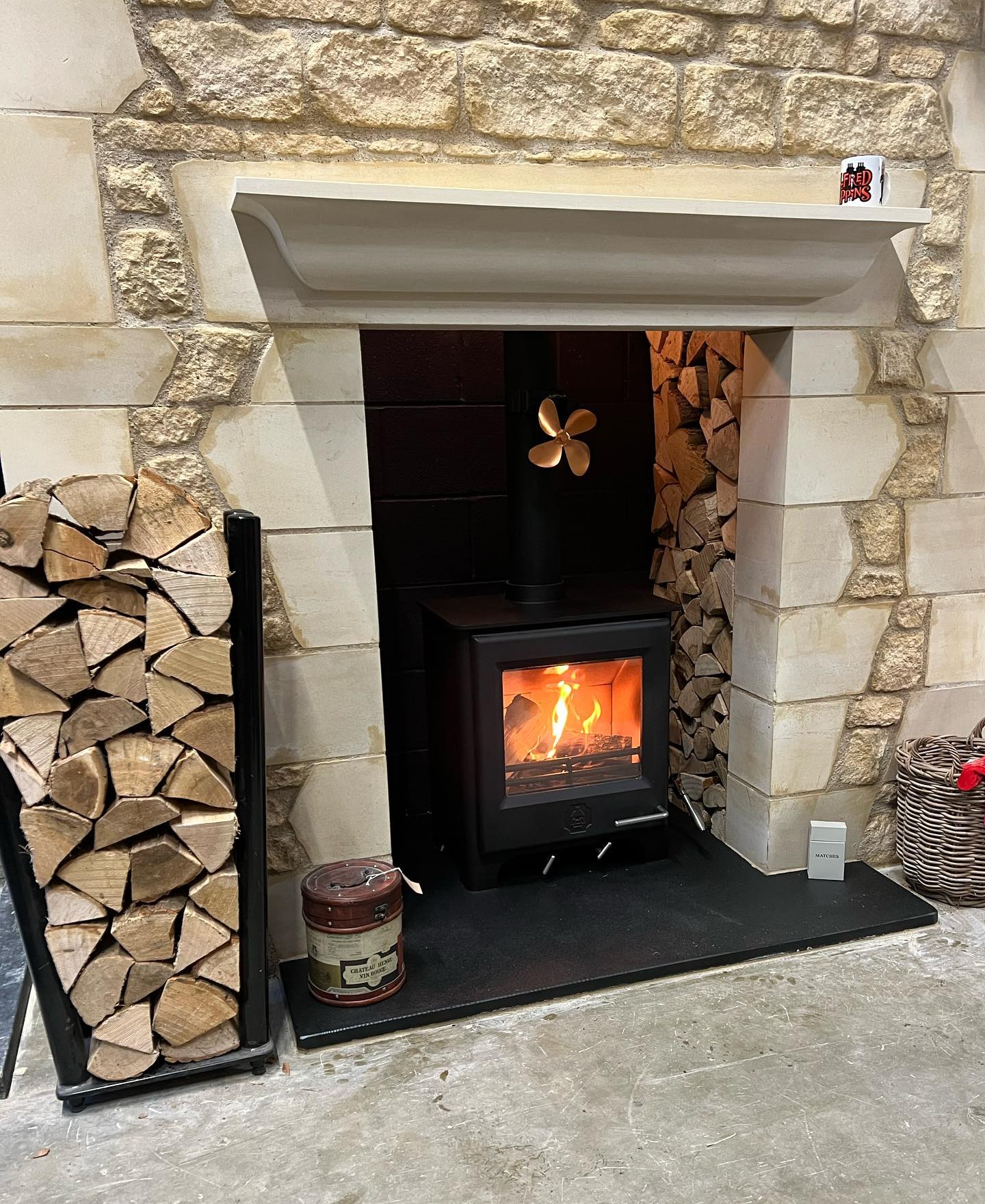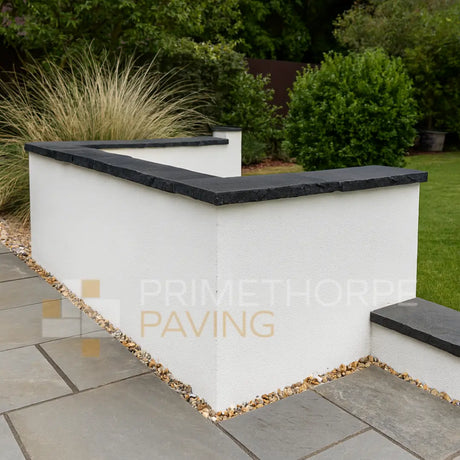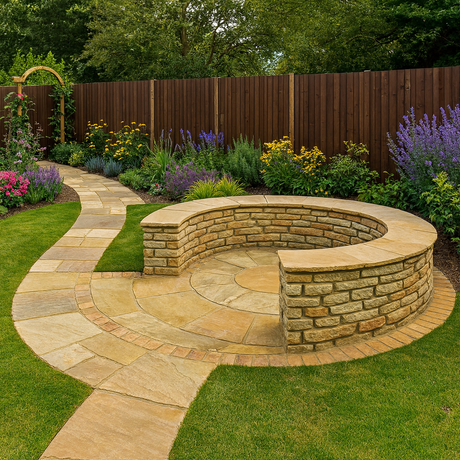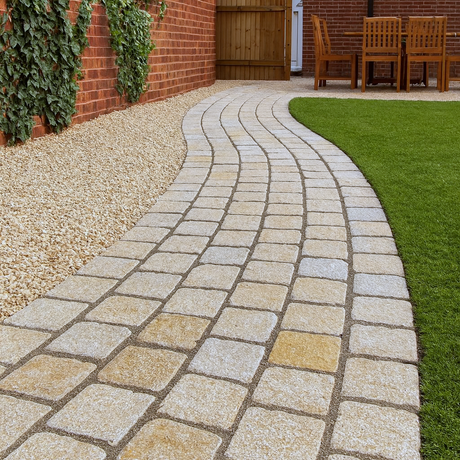When it comes to installing a fireplace hearth, the phrase "safety first" is more than just a saying; it's an essential principle. While the aesthetic appeal of a beautiful hearth can transform a room, understanding and adhering to hearth clearance regulations is crucial to ensure the safety and efficiency of your fireplace.
Why Hearth Clearance Regulations Matter
In the cosy corners of British homes where fireplaces take pride of place, the hearth not only adds warmth but also brings a sense of comfort and style. However, beneath this inviting facade lies a critical aspect – safety clearances for fires, walls, and floors. These regulations aren't just bureaucratic red tape; they are meticulously designed to prevent accidents, protect your home, and optimise the functionality of your fireplace.
Whether you’re installing a traditional wood-burning stove or a sleek, modern gas fireplace, compliance with safety clearance regulations is non-negotiable. It's about safeguarding your family, preserving your property, and ensuring that your peaceful evening by the fire remains just that - peaceful and safe.

Navigating the World of Hearth Regulations
Understanding hearth clearance regulations can be overwhelming for many homeowners. Terms like 'minimum dimensions' and 'safety clearances' might seem daunting at first glance. But fear not! This guide is designed to demystify these regulations, breaking them down into understandable segments. We’ll explore what these rules mean in practical terms and how you can apply them to various types of homes and fireplace setups.
Join us as we delve into the world of hearth safety. By the end of this guide, you'll not only be informed about the necessary regulations but also be equipped with the knowledge to apply them effectively in your home.
Decoding the Hearth Safety Regulations
Understanding the Fundamentals of Hearth Safety
Safety clearances for hearths are not just about following rules; they're about creating a safe environment for you and your loved ones. These regulations are set to minimise the risk of fires and ensure that your fireplace operates efficiently and safely.

The Basics of Hearth Safety Clearances
According to UK building regulations, the minimum dimensions for hearth safety are critical to prevent accidental fires. These dimensions are designed to protect combustible materials in and around your fireplace from the intense heat it generates.
Minimum Distance from Combustibles:- For most wood-burning stoves, a minimum clearance of 300mm (12 inches) is required from the stove to any combustible material. This distance may vary depending on the type of stove and its heat output.
- For gas fireplaces, which typically emit less heat than wood burners, the clearance can be less. However, it’s crucial to follow the manufacturer's guidelines for specific models.
Hearth Size Regulations:
- For an open fire, the hearth should extend at least 500mm (20 inches) in front and 150mm (6 inches) on either side of the fireplace opening. This is to ensure that any stray sparks or embers don't land on a combustible surface.
- In the case of stoves, the hearth should extend a minimum of 225mm (9 inches) in front of the stove door.
Floor Protection:
- For hearths used with log burners or multi-fuel stoves, the floor underneath must be non-combustible. This is essential to prevent any heat from the stove from igniting the floor material.
- The thickness of the hearth is also regulated, with a minimum depth of 12mm for non-combustible materials.
Applying These Dimensions in Your Home
It's important to consider these regulations as a starting point. Your specific fireplace or stove may have unique requirements based on its design and heat output. Always consult the manufacturer’s guidelines or a professional installer to ensure you meet the necessary safety standards.

By understanding these fundamental safety clearances and applying them correctly, you can enjoy the warmth and ambiance of your fireplace without worry.
Hearth Placement and Material Considerations
Choosing the Right Materials for Safety and Style
The material of your hearth not only defines its aesthetic appeal but also plays a crucial role in ensuring safety. Different materials offer varying levels of heat resistance and durability, making the choice an important one.
Stone Hearths:
- Sandstone and Slate: Popular for their rustic charm, these materials are excellent for traditional setups. They offer good heat resistance but require sealing to prevent stains and damage.
- Granite: A top choice for modern homes, granite is highly durable and resistant to heat. Its polished or honed surface adds a sleek, contemporary look.
- Limestone: Known for its consistent colour and smooth texture, limestone suits both traditional and modern designs. It’s relatively soft, so extra care is needed to avoid scratches.
Safety with Style:
- While aesthetic preferences play a big part in material choice, it’s essential to consider how these materials react to heat. For example, granite and slate offer higher heat resistance compared to sandstone. But sandstone retains heat better, so will keep the room warmer for longer.
- The thickness of the hearth material also contributes to safety. Thicker materials generally provide better insulation, reducing the risk of heat damage to the floor.

Ensuring Proper Placement for Optimal Safety
Positioning your hearth correctly is as important as choosing the right material. Here are a few tips to ensure your hearth is placed safely:
- Proximity to Walls and Furniture: Keep a safe distance between the hearth and any nearby walls or furniture. This reduces the risk of heat damage or accidental fires. The hearth itself should act as a perimeter for safety against sparks and embers, but even so, try to leave a minimum of 1.5m between your hearth and anything flammable.
- Level Surface: Ensure that the hearth is installed on a level surface. An uneven hearth can lead to instability, increasing the risk of accidents.
- Professional Installation: Consider hiring a professional for installation. They can ensure that your hearth complies with safety standards and is positioned optimally for both safety and aesthetics.

Practical Application in Home Settings
Tailoring Hearth Safety to Your Home
Adhering to safety clearances is not a one-size-fits-all solution. The type of home, fireplace, and your lifestyle all play a role in how you apply these regulations. Here are some practical ways to ensure safety in various home settings:
In Smaller Apartments or Compact Spaces:
- Space-Saving Solutions: For smaller areas, consider slimline hearths that comply with safety regulations while not overwhelming the space.
- Material Choices: Opt for materials that reflect light and give a sense of spaciousness, like polished granite or light-coloured limestone.
In Large, Traditional Homes:
- Making a Statement: Larger homes can accommodate grander hearth designs. Rustic materials like slate or sandstone can complement the traditional aesthetics.
- Safety in Spaciousness: Utilise the ample space to exceed minimum safety clearances, offering an extra layer of security and peace of mind.
In Modern Houses:
- Sleek and Contemporary: For contemporary homes, consider hearths with clean lines and minimalistic designs. Polished granite limestone can offer a modern look while ensuring safety.
- Integrating Technology: Modern homes might also include smart systems for fire safety. Ensure these are compatible with your hearth and fireplace setup.

Adapting to Different Fireplace Types
Different fireplace types might require unique approaches to hearth installation and safety:
- Open Fires: Are slowly being made redundant, but if you are hoping to have an open fire, restrictions are incredibly strict and you must spend lots of time ensuring you adhere to them.
- Log-Burning Stoves: Often need more substantial hearth materials to handle the high heat output. Consider thicker slabs of granite or slate. See our log burner hearth ideas article for more information.
- Gas Fireplaces: Usually have lower heat output, allowing for more flexibility in material and design choices.
Expert Tips for Hearth Installation
Ensuring Safe and Compliant Hearth Installation
While selecting the right material and design for your hearth is crucial, equally important is its proper installation. A well-installed hearth not only enhances the safety of your fireplace but also contributes to the overall aesthetic of your home. Here are some expert tips to ensure your hearth is installed correctly and safely:
Professional Assessment:
- Consult Experts: Before installation, it's advisable to consult with a fireplace or hearth installation expert. They can assess your specific needs, considering the type of fireplace, room layout, and home style.
- Custom Solutions: Experts can provide tailored advice on the best materials and installation methods for your particular setup, ensuring both safety and design cohesion.
Attention to Detail:
- Precision in Measurements: Accurate measurements are key to a successful hearth installation. Ensure all dimensions meet the safety standards and align perfectly with your fireplace.
- Quality Check: Inspect the hearth material for any defects or inconsistencies before installation. Any imperfections should be addressed to avoid future complications.
Installation Best Practices:
- Level and Secure: The hearth should be installed on a level surface and securely fixed to avoid any movement, which could pose a safety risk.
- Heat Resistant Adhesives and Materials: Use high-quality, heat-resistant adhesives and materials during installation to ensure long-lasting durability and safety.
Post-Installation Inspection:
- Safety Inspection: After installation, conduct a thorough safety inspection to ensure all clearances are met and there are no risks of fire hazards.
- Functional Testing: If possible, test the fireplace with the new hearth in place to check for any issues with heat transmission or material integrity.

Which Hearth Material is Best for Heavy Usage
Selecting the Ideal Material for High-Demand Hearths
In homes where the hearth is not just a decorative element but a key heat source, choosing the right material becomes even more crucial. Here, we discuss which materials are best suited for heavy usage, ensuring longevity and safety.
Granite: The Premium Choice
- Durability: Granite stands out for its exceptional durability. It can withstand high temperatures and frequent use without showing wear.
- Maintenance: Easy to clean and maintain, granite is ideal for those who use their hearth regularly.
Slate: Traditionally Resilient
- Heat Resistance: Slate's natural ability to withstand high heat makes it a strong contender for heavy use.
- Aesthetic Appeal: It retains its rustic charm over time, even with regular use.
Limestone: Elegance with Caution
- Consistent Look: Limestone offers a modern, consistent appearance, but it requires careful maintenance.
- Suitability: Best for homes where the hearth is used frequently but with care.
Sandstone: For the Rustic Touch
- Natural Beauty: Sandstone provides a natural, earthy look but is more susceptible to wear.
- Consideration: It's suitable for regular use, provided it's sealed and maintained properly.

Conclusion: Making the Right Choice for Your Home
Selecting the right material for your hearth is a balance between aesthetic preferences, usage patterns, and maintenance considerations. While granite and slate offer durability and resilience for heavy usage, limestone and sandstone bring unique beauty but require more care.
Your hearth is more than just a part of your home's heating system; it's a focal point of beauty and warmth. By choosing the right material, you ensure that your hearth remains a source of comfort and joy for years to come, enduring through countless family gatherings and cosy nights by the fire.






